Plants have been an integral part of Animal Crossing since the beginning. Flowers and trees used to be the only way to decorate outside. Now we can place furniture outside and terraform to our heart’s content, but that doesn’t mean we leave behind our naturally growing plants. I like to cover my island with plants to give it a natural feel. It really makes my island dynamic as it changes with the seasons. Windy days are especially my favorite because I get to watch the leaves and flowers sway.
We have access to many different kinds of plants now, and they each grow in their own way and can serve purposes other than just decoration. It can be hard to know what rules each plant follows when there are so many of them, and most aren’t explained in the game.
I used to keep a cheat sheet on my desk with a checklist of all the flowers I had managed to grow and the combinations I had left. Every time my niece visited my island, I would convince her to help me water my flowers to increase my chances of growing something new. Now the best part of my island is the museum’s garden, filled with every kind of flower arranged in a chaotic rainbow.
The Basic Botany
All the plants in Animal Crossing can fit into one of five categories, flowers, trees, bushes, crops, or overgrowth. Within those categories, there is variation in type, color, seasonality, and use, and each category has its own rules for planting, growing, and harvesting. While some plants spawn naturally on your island, you may have to do a little work to obtain others.
Let’s take a look at each type of plant in-depth below.
Flowers
Flowers are the plants with the widest variety and can be the hardest to obtain. There are nine different kinds of flowers, and most have six to nine color variations. To collect all of them, without the help of time travel or another player, you must rely on luck, consistent work, and time.
You can move flowers by digging them up with a shovel. Flowers can be placed on any ground you can dig in but will not grow further when planted on the beach. They take up one tile and space and can be walked through. If you run through your flowers, there is a chance the petals will fall off, but they will regrow in two days.
Picking the flowers will also result in the plant losing its petals but regrowing them. Once harvested, flowers can be used as furniture, gifts, clothing, or crafting materials.
Obtaining Flowers
You will start with one flower that is native to your island. It is randomly chosen, and you have no control over it. Your native flower will begin in three different colors, usually some variation of white, red, and yellow. Other breeds of flowers can be found on mystery islands or by buying seeds from Leif and Nooks Cranny. This will also only get you the base colors of any flower.
If a flower is watered by a watering can, rain, or snow, there is a chance it will grow a new flower. This is how you can get hybrid colors. A single flower can only produce flowers of the same color, but flowers grown next to each other may make a new color; these are called hybrids. Each breed of flower creates different hybrids through different combinations. I recommend planting your flowers in a checkerboard pattern when breeding to allow room for new flowers to grow with maximum breeding options.
Cosmos
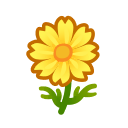
Cosmos are fairly standard-looking flowers with a circle of pollen surrounded by eight heart-shaped leaves. The stem is green with long, thin leaves that branch off each other. The orderly arrangement of petals has made cosmos a symbol of order and harmony in the world of flowers.
Base Colors
- White
- Red
- Yellow
Hybrid Colors
- Pink
- Made by breeding red and white.
- Orange
- Made by breeding red and yellow.
- Black
- Made by breeding two oranges.
Hyacinths

Hyacinths come in various pastel colors. They are comprised of many tiny flowers coming together to form an oval shape. Their stems are light green, and two long, slightly pointed leaves wrap around them. Hyacinths have roots in greek mythology from the story of Apollo and Hyacinthus. They symbolize peace, commitment, beauty, power, and pride. These are my favorite flowers due to their tall shape and soft colors. My island entrance is absolutely covered in them.
Base Colors
- Red
- White
- Yellow
Hybrid Colors
- Blue
- Made by breeding white and white.
- Orange
- Made by breeding red and yellow.
- Pink
- Made by breeding red and white,
- Purple
- Made by breeding orange and blue, two oranges, or two blues.
Lilies
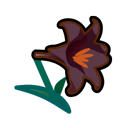
Of all the flowers, lilies are the sharpest. They have a cone-like shape filled with long stamens and six pointy petals flaring out at the top. The stems have rows of pointed, dark green leaves surrounding them. There are many different kinds of lilies in the world, and they symbolize purity, innocence, and rebirth.
Base Colors
- Red
- White
- Yellow
Hybrid Colors
- Pink
- Made by breeding red and white.
- Orange
- Made by breeding red and yellow.
- Black
- Made by breeding two reds.
Mums
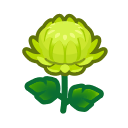
“Mums” is short for chrysanthemums. They look like cute little pom-poms. They are comprised of tons of thin, long petals that radiate out from the center, getting further apart the farther out they are. They have two diamond-shaped leaves, one on either side of their stem. In real-life, chrysanthemums come from China and symbolize longevity, fidelity, joy, and optimism.
Base Colors
- Red
- White
- Yellow
Hybrid Colors
- Pink
- Made by breeding red and white.
- Purple
- Made by breeding either two white or two yellow.
- Green
- Made by breeding two purple.
Pansies
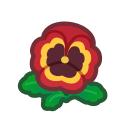
Pansies are the shortest of the available flowers. They are close to the ground and surrounded by three wide, dark green leaves with four large, overlapping petals surrounding a small pollen circle. Their petals have two colors: the exterior color the flower is named after and a darker inner color, usually black. Pansies symbolize love in all forms, romantic, platonic, and sometimes secret.
While visually, there are only six different colors, there are technically seven. Red pansies can either be the basic kind that grows from seeds or hybrid. There is no visual difference between the two; you can only tell if you are keeping track of where your flowers came from or what they produced. Hybrid reds can be used to breed rare colors.
Base Colors
- Red
- White
- Yellow
Hybrid Colors
- Orange
- Made by breeding red and yellow.
- Blue
- Made by breeding two whites.
- Hybrid-red
- Made by breeding red and blue.
- Purple
- Made by breeding either two oranges, two blues, or two hybrid reds.
Roses
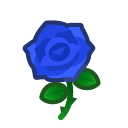
Of all the flowers, roses are one of the most beautiful and iconic. Many flowers can be mistaken for each other but never roses. That’s why in Animal Crossing, they are given special treatment. Roses have more color variation than any other flower, including gold, and some colors are extremely hard to get. Like pansies, there are regular and hybrid red roses, but unlike pansies, hybrid reds are necessary to get rarer colors.
Roses are a complex and concise arrangement of delicate petals. Their stems have two serrated leaves and a handful of thorns. Typically, they symbolize love, beauty, and courage. Still, dozens of meanings are given to specific colors across different cultures.
Base Colors
- Red
- White
- Yellow
Hybrid Colors
- Pink
- Made by breeding red and white.
- Orange
- Made by breeding red and yellow.
- Purple
- Made by breeding two whites.
- Black
- Made by breeding two reds.
- Hybrid Red
- Made by breeding two oranges or an orange and a purple.
- Blue
- Made by breeding two hybrid reds.
- Gold
- Made by breeding two blacks watered with a golden watering can.
Tulips
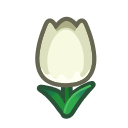
Tulips are delicate flowers with soft petals overlapping each other to make a smooth cup-like shape. Their leaves sprout from the base of the stem to form a wide v. Like roses, tulips can symbolize many different things based on their colors, but the most popular meanings are red for perfect love and purple for royalty.
Base Colors
- Red
- White
- Yellow
Hybrid Colors
- Pink
- Made by breeding red and white.
- Orange
- Made by breeding red and yellow.
- Black
- Made by breeding two reds.
- Purple
- Made by breeding two oranges or an orange and a black.
Windflowers
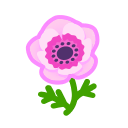
Two layers of five petals each made a relatively flat circle with a dark spot in the center of the windflower. Small green leaves branch out like fans from the thin stem. Windflowers don’t symbolize the same happy and positive traits as our other flowers. In some cases, they represent the arrival of spring, but they can also symbolize the loss of a loved one or forsaken love.
Base Colors
- Red
- Orange
- White
Hybrid Colors
- Pink
- Made by breeding red and orange.
- Blue
- Made by breeding two whites or a white and an orange.
- Hybrid Red
- Made by breeding a red and a blue
- Purple
- Made by breeding either two hybrid reds or two blues
Lily of the Valley
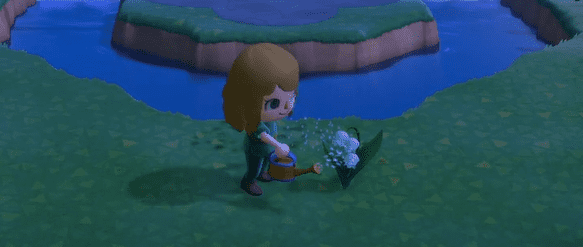
Lilies of the Valley are a special kind of flower in Animal Crossing. They only come in one color, do not grow, and can’t be found or bought. This flower appears on your island when you have met certain qualifications and is a reward for good gameplay. Once your island has a five-star rating, there is a chance a lily of the valley will spawn on an empty cliff. If you are having trouble getting a lily of the valley, ask Isabelle about island evaluations. She will tell you your island rating, and if it isn’t five, she will give you tips on what you can improve.
You can’t pick a lily of the valley, and they don’t lose their petals when you run through them. They will always look the same, and you can only use them as flowers. They aren’t part of any DIY recipe and can’t be worn or placed anywhere as furniture.
The flowers hang in a bell-like shape on curved stems. They have two leaves curving out from the base of the stem, one larger and one smaller. Despite the name and various species of lilies, lilies of the valley aren’t true lilies and are more closely related to asparagus. They symbolize purity, youth, sincerity, and discretion.
Trees
The second most prevalent plant after flowers is trees. Like flowers, they are important decorations on your island from the beginning. However, they are much easier to manage and offer a lot more in the way of functionality. They offer crafting materials, and certain bugs will only spawn on certain trees.
Trees take up one space but can’t have certain things in the eight tiles surrounding their trunk. Water and cliffs must be at least one tile away from a tree trunk. If you try to place a tree next to a cliff or river, it will tell you there isn’t enough space, and if you try to make a cliff or river next to a tree while terraforming, you will be told it’s too dangerous. You also can’t place trees directly next to each other.
You can move trees by eating food and digging the tree up with a shovel. The tree will then be in your pocket, and you can place the tree on any soft ground where there’s enough space.
All trees will give wood when chopped with an ax. You can get three pieces of wood daily, but if you use an ax, you’ll chop down the tree. Using a stone or flimsy ax will leave the tree in place. Shaking hardwood and cedar trees will result in falling materials. Most of the time, this will be branches or seasonal supplies. However, each day there will be random trees with special items: five trees will have wasps, five will have 100 bells, and two will have furniture.
Growing Trees
While technically you can get a fully grown tree immediately by digging one up at a mystery island, it’s easy enough to just grow your own trees. Each tree is grown by planting a sapling, shoot, or fruit. Over four days, the tree will grow a bit each day until it is fully grown. You will not be able to use the tree for anything other than decoration until it has grown.
You’ll need to plant them with enough space for the tree to grow. There can’t be cliffs, water, or other trees within two tiles of the sapling. If you try to plant a sapling somewhere it can’t grow, it will be planted but remain the same size. You can have trees one tile away from each other, but to achieve this, you’ll have to grow the tree somewhere else and then move it once it’s fully matured.
To remove trees, you need to use an ax to cut them down. After three hits, the tree will fall, and a stump with be left over. You can leave the stump to attract bugs or use a shovel to get rid of it.
Hardwood Trees
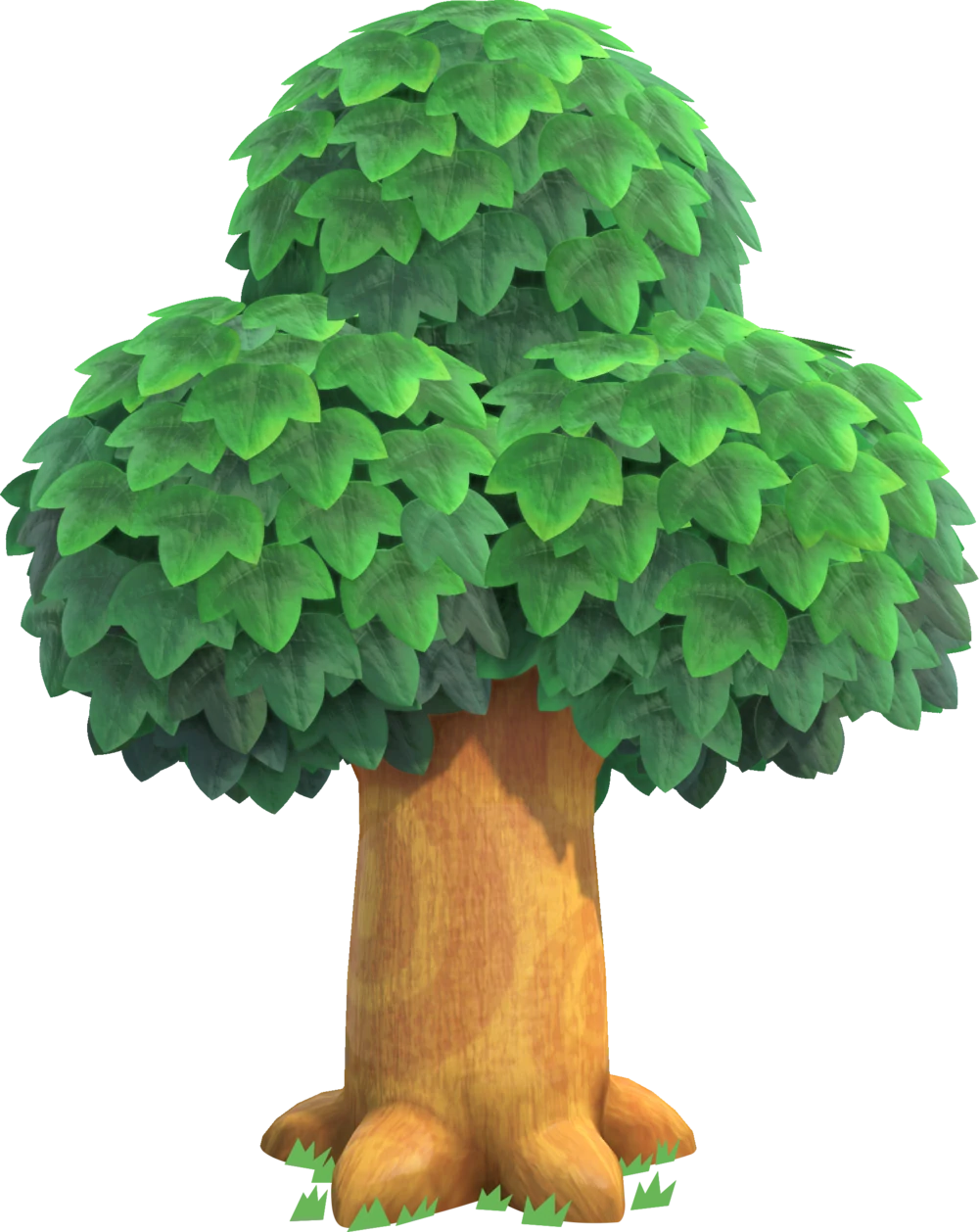
Hardwood trees are the most basic of Animal Crossing trees. They look like your typical deciduous tree with a brown trunk and green leaves hanging off branches. The colors of the trunk and leaves change to match the seasons. However, they don’t lose leaves in the winter as real-life trees do.
Two seasons make hardwood trees special. In the fall, hardwood trees will drop acorns and branches, and in the first ten days of April, they will change into cherry blossom trees.
You can plant a hardwood tree with a sapling that can be bought at Nook’s Cranny or Leif’s shop. Saplings can also be found in the recycling bin. However, you begin the game with plenty of hardwood trees on your island.
Materials Given
- Wood
- Hardwood
- Softwood
- Branches
- Acorns
Cedar

The cedar trees look like typical evergreen trees. Rather than the round bunches of leaves the hardwood trees have, they have darker needles forming a cone above a dark brown trunk. They don’t change with the seasons, except for being covered with snow in the winter.
Two seasons change cedar trees. At the same time in the fall that hardwood trees are dropping acorns, cedar trees will drop pinecones. Then in December, some cedar trees will be decorated with Toy Day lights. These trees can be shaken to get ornaments.
Since cedar trees function similarly to hardwood trees, they are obtained in the same way. Some are already on your island when you begin, but you’ll have to unlock the ladder to reach them. Planting them requires a cedar sapling purchased from Leif or Nook’s Cranny or found in the recycling bin.
Materials Given
- Wood
- Hardwood
- Softwood
- Branches
- Pinecones
- Ornaments
Fruit Trees
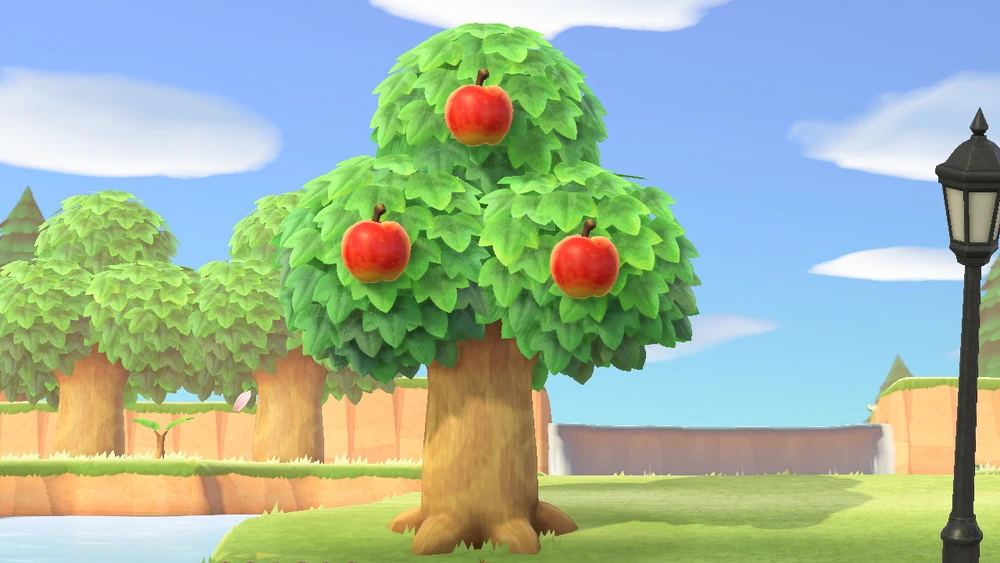
Fruit trees look exactly like hardwood trees, with the addition of three fruits resting among the leaves. You can still get wood by chopping the trees but shaking them will not give branches or other items. Shaking the trees will cause any fruit in the branches to fall. Three days after the fruit is harvested, new fruit will grow back.
Rather than saplings, fruit trees are planted by burying fruit in the ground. They take the same amount of time to grow and will produce fruit when fully grown. Acquiring fruit to plant can be tricky. You begin with one fruit native to your island. Then you can find one other fruit when you visit certain mystery islands. Within the first few days of gameplay, you’ll receive another non-native fruit in a letter from your mom. Other than that, you’ll have to either hope you receive fruit as a gift from your villagers or visit friends’ islands and share your fruits.
There are five different types of fruit trees available in New Horizons. This makes me a little disappointed since there used to be more fruits in older games. I will always miss you, my beloved lemon trees.
- Apple
- Pear
- Peach
- Cherry
- Orange
Palm Trees
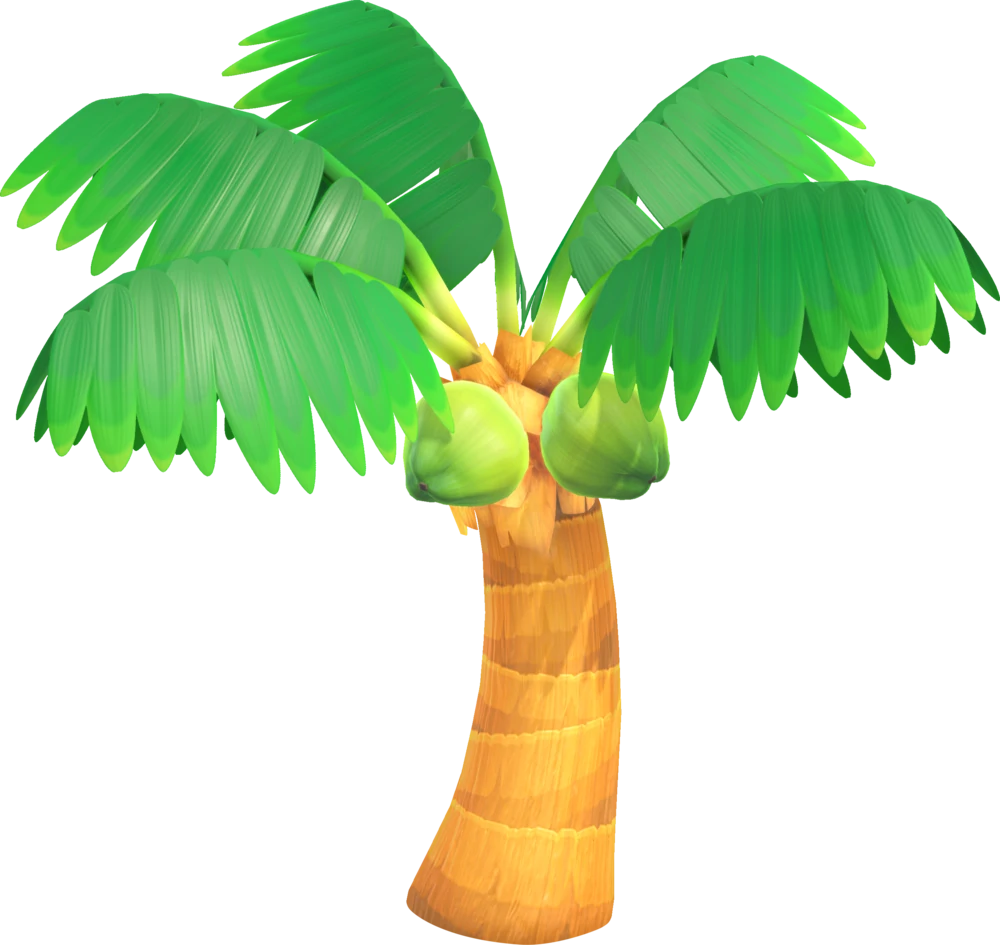
Palm trees work the same way fruit trees do, except they give only two coconuts when harvested and will only grow in sand. Their long trunks curve slightly and are covered in rings. They have five large leaves branching out from the top of the trunk. The most expensive and rare bugs spawn on palm trees on summer nights.
Money Tree
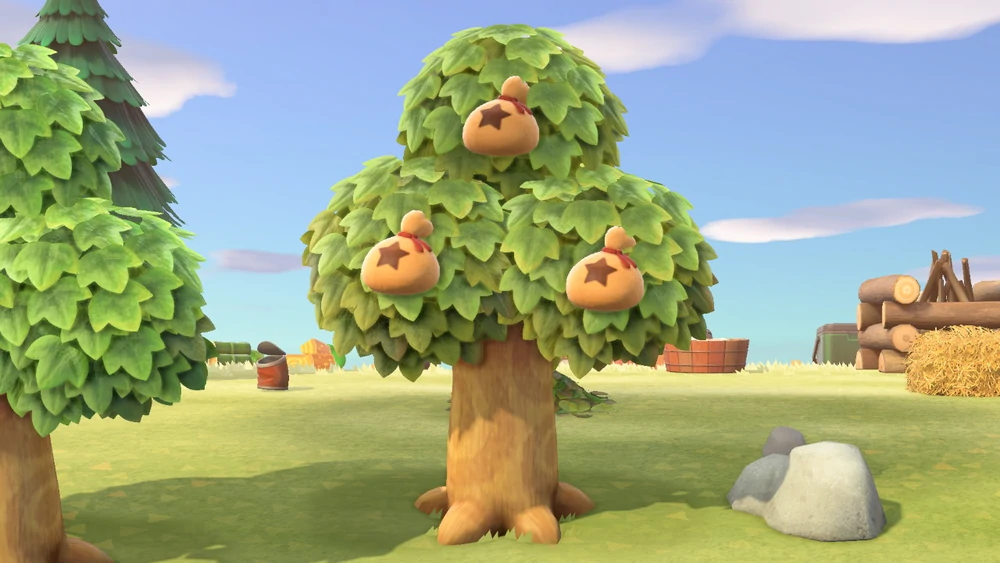
Once again, the money tree is like a fruit tree, but it will only grow once, and only one can be planted once a day. Every day on your island, there with be a small glowing spot on the ground. If you dig there, you will find 1,000 bells. The hole you dug will emit a glow; if you bury money in it, a tree sapling will sprout. Burying anything else will result in it acting like any other buried object.
The amount of money you bury will affect the amount the tree will produce when it grows. However, very few amounts can be guaranteed because, depending on what you plant, multiple return options are left to chance.
If you plant 100-1,000 bells, you’ll be guaranteed a return of 3,000 bells. Any amount above 1,000 and below 10,000 has a 30% chance of tripling the amount buried but a 70% chance of only returning 3,000.
Planting 10,000 bells will guarantee a return of 30,000 bells. Anything above 10,000 has a 30% chance of being tripled and a 70% chance of only returning 30,000.
My personal recommendation is to plant 10,000 bells every day. It’s a guaranteed constant profit of 20,000 bells, and you’ll never lose money.
Bamboo
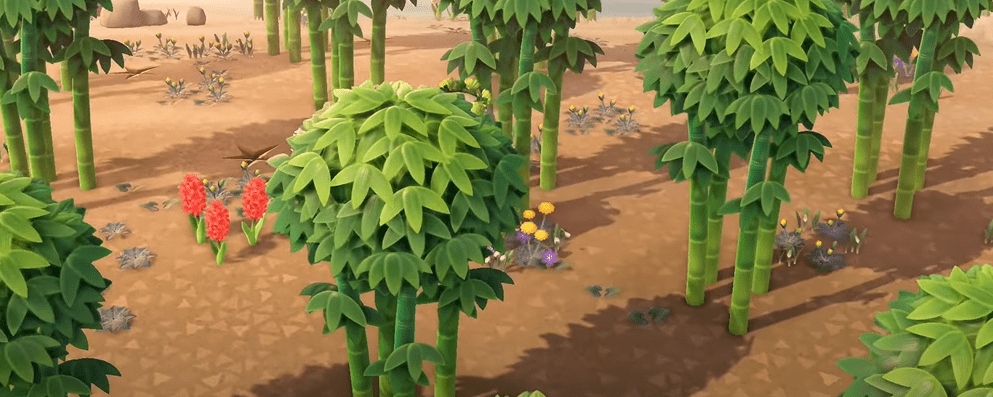
While bamboo technically isn’t a tree, in Animal Crossing, it follows the same rules as trees, so I’m including it here. Bamboo appears as three stalks supporting a round bunch of leaves with smaller bunches of leaves midway up each stem. It can be chopped like trees, but shaking it won’t affect it. During the spring, chopping bamboo might result in the seasonal martial, young spring bamboo.
You have to do a little more work to be able to plant bamboo than regular trees. It grows from bamboo shoots which can’t be bought anywhere. Shoots can only be obtained by finding a bamboo mystery island or being gifted bamboo shoots by Daisy Mae after buying turnips. Though once you’ve got fully grown bamboo, shoots will occasionally spawn digging spots that will have new shoots. Alongside planting, you can also use shoots for DIY and cooking recipes.
Materials Given
- Bamboo
- Young Spring Bamboo
- Shoots
Bushes
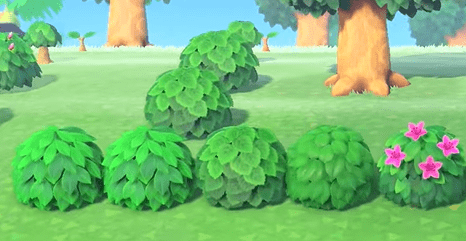
Bushes take up one tile of space and grow seasonal flowers. The flowers can’t be picked, but the shrubs can be used like a fence as they can’t be moved without digging them up. Shrubs can be obtained by buying starts from Leif or digging up the shrubs found on boat tour islands. After a start is planted, it will take three days to grow.
There are seven different kinds of bushes. All but one come in two colors, and the blooming bush changes every few months, so there is always one in season. The blooming seasons differ in the Northern and Southern Hemispheres.
- Camelias: January 1 to March 31 in the North, June 16 to September 30 in the South
- Pink
- Red
- Azaleas: April 11 to May 31 in the North, October 11 to November 30 in the South
- Pink
- White
- Plumerias: June 1 to September 20 in the North, December 1 to March 20 in the South
- White
- Pink
- Hydrangeas: June 1 to July 20 in the North, December 1 to January 20 in the South
- Purple
- Blue
- Hibiscus: July 21 to September 20 in the North, January 21 to March 20 in the South
- Red
- Yellow
- Tea Olives: September 21 to October 30 in the North, March 21 to April 30 in the South
- Yellow
- Orange
- Holly: November 1 to December 31 in the North, May 1 to June 15 in the South
Vegetables and Other Crops
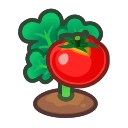
Growing crops is a new addition to the Animal Crossing series. We got a sneak peek of it in October 2020 when we got pumpkins in the Halloween update. Then the 2.0 update gave us a whole load of crops to grow. Vegetables are used primarily as decoration and ingredients for cooking recipes. You can also eat raw vegetables, but I don’t find that as fun as making a small meal. Who wants to eat raw wheat?
There are six crops that you can grow. Pumpkins are the only ones that have different variations. Most DIYs and recipes only use orange pumpkins, while the other colors are used to customize Halloween furniture.
- Wheat
- Sugarcane
- Potatoes
- Tomatoes
- Carrots
- Pumpkins
- Orange
- White
- Green
- Yellow
You can grow vegetables by either planting starts or burying a vegetable. Starts can be bought from Leif, and you can harvest them to plant more. Kapp’n also sometimes takes you to a mystery island where one kind of crop will grow, and you can gather it there and bring it home.
After you’ve planted your vegetable, it will take a few days to grow. Once it is fully developed, you can harvest it, and it will revert to how it looked when planted and regrow over the next few days. The harvest from your plant can be from one to three vegetables. The amount you get is dependent on how much you water it. If you water your crop every day, you’ll get three. If you water it on some days, it’ll grow two; if you never water it, there will only be one.
Overgrowth
Unlike the other flora we’ve looked at, weeds, moss, vines, and mushrooms don’t grow. They don’t take a few days to get to their full size and start producing materials; they are the materials and don’t change much in appearance. They can be picked up and placed at your discretion, leaving nothing behind. All are used as crafting supplies.
Weeds

Weeds are the only one of the three that are native to your island. They can also be a bit of a hassle. Too many weeds can lower your island’s rating, and the more weeds you have, the more they will spread. Two weeds are guaranteed to spawn on your island daily, but weeds that stay the night will likely create more weeds next to them. You can get rid of them by picking them or paying Leif to remove them for you if there are too many to deal with.
There are four sizes that weeds can appear in. They all take up one tile of space, but the density and height of the weeds change. Typically a newly grown weed will be small and will grow over time. However, the size of the weed does not affect it as an item. Small weeds and large weeds all only count as one once picked. When you plant a weed, its size will be random, and if you are looking for a specific one, you can pick it back up and place it until you get the one you want.
Glowing Moss
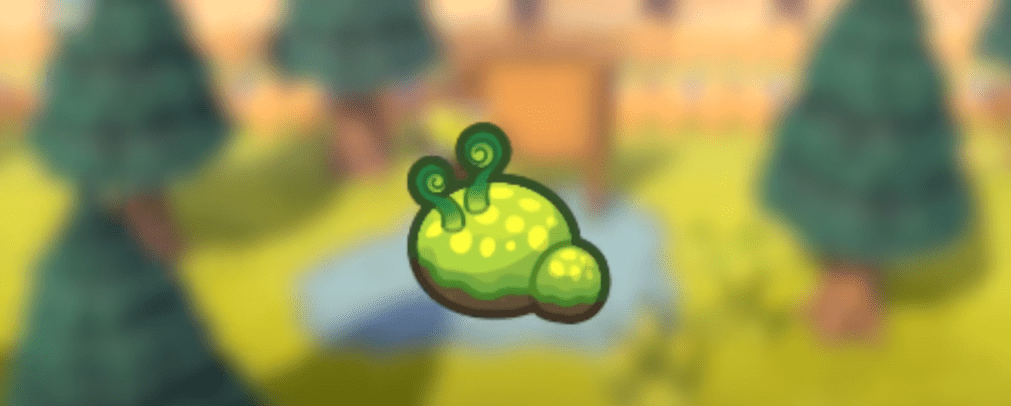
Glowing moss works in a similar way to weeds. It can be planted on the ground and, when placed, will appear in one of four sizes. You can change the size by picking it up and placing it again. Moss, however, will not grow on your island. The only way to get more moss is to find the moss and vine island on Kapp’n’s Boat Tour or buy the Happy Home Paradise DLC. All year glowing moss maintains the same mystical look.
Vines

Vines and moss are often paired together. They are found in the same places and don’t grow on your island. What makes vines special is that they aren’t placed on the ground. Instead, they are placed on cliffs. When placed, you can use the vines like a ladder to climb up and down the cliff. The colors of vines change with the seasons, but there are no variations in shape or size.
Mushrooms

You don’t have to do anything special to get mushrooms on your island; much like weeds, they will naturally spawn on the ground. However, they are seasonal, so they will only grow in November for the northern hemisphere and May for the southern hemisphere. Each day in season, five mushrooms will spawn near hardwood trees. There are five kinds of mushrooms, each with a varying rarity that is affected by your island rating. You can eat the mushrooms or use them in cooking and crafting. Personally, I use most of my mushrooms for crafting because I’m in love with the mush furniture.
Types of Mushroom and Chances of Spawning
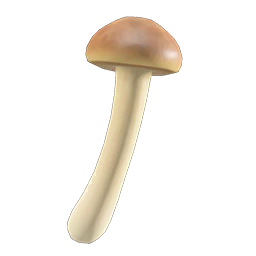
- Round Mushroom
- 3 or fewer stars: 30%
- 4 stars: 25%
- 5 stars: 25%
- Skinny Mushroom
- 3 or fewer stars: 35%
- 4 stars: 30%
- 5 stars: 25%
- Flat Mushroom
- 3 or fewer stars: 30%
- 4 stars: 30%
- 5 stars: 25%
- Elegant Mushroom
- 3 or fewer stars: 4%
- 4 stars: 10%
- 5 stars: 15%
- Rare Mushroom, which is always found underground
- 3 or fewer stars: 1%
- 4 stars: 5%
- 5 stars: 10%
FAQs
Question: Where do I get Plants in Animal Crossing?
Answer: This really depends on the type of plant. Tree saplings, seeds, and starts can be bought from Leif. Fruit, saplings, and seeds can be purchased at Nooks Cranny. All mystery islands have some kind of plants that can be dug up and brought to your island. If you are looking for potted plants, those are categorized as furniture and can be bought at Nook’s Cranny.
Question: What Plants can I Plant in Animal Crossing?
Answer: Trees, flowers, bushes, and vegetables are all plants that can be planted in Animal Crossing. They vary in the ways they are planted, but all will grow if planted in the right conditions.
Question: How do you get Potted Plants in Animal Crossing?
Answer: You can place flowers as furniture, but they appear in vases rather than pots. If you want a plant in a pot, like a houseplant, you’ll need to buy or craft it. They are furniture rather than flora and don’t grow.
Question: How do I get Leif to Open a Shop?
Answer: Leif does not open a shop on your island. Once he starts visiting, he will be at your plaza for a whole day, roughly every other week. However, once you unlock Harv’s Island, there is a gyroid there that takes donations for Leif to have a trailer in the artists’ collective.
- Rodney Animal Crossing Guide - January 26, 2023
- Rarest Fish in Animal Crossing - January 1, 2023
- Squirrels Animal Crossing Guide - December 27, 2022
